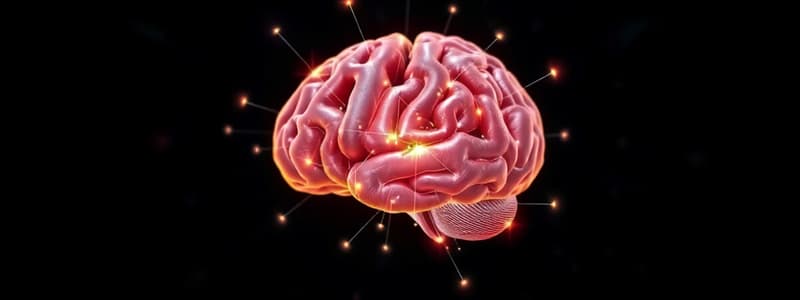Podcast
Questions and Answers
The major output pathway for hippocampal communication related to memory is the ______.
The major output pathway for hippocampal communication related to memory is the ______.
fornix
The ______ acts as a memory relay station to the cortex, critical for alertness.
The ______ acts as a memory relay station to the cortex, critical for alertness.
anterior thalamic nucleus
The part of the limbic system that contributes to recognition memory processing is called the ______.
The part of the limbic system that contributes to recognition memory processing is called the ______.
mammillary body
The ______ is crucial for converting short-term memories into long-term ones, housing the hippocampus.
The ______ is crucial for converting short-term memories into long-term ones, housing the hippocampus.
Signup and view all the answers
For object recognition and memory formation, the ______ and entorhinal cortex play a key role.
For object recognition and memory formation, the ______ and entorhinal cortex play a key role.
Signup and view all the answers
The ______ facilitates memory encoding and retrieval, especially for spatial awareness.
The ______ facilitates memory encoding and retrieval, especially for spatial awareness.
Signup and view all the answers
The ______ is involved in emotional value assessment and reward processing.
The ______ is involved in emotional value assessment and reward processing.
Signup and view all the answers
Managing emotions and autonomic functions is a function of the ______.
Managing emotions and autonomic functions is a function of the ______.
Signup and view all the answers
The ______ is crucial for developing emotions like fear and memory storage based on emotional impact.
The ______ is crucial for developing emotions like fear and memory storage based on emotional impact.
Signup and view all the answers
For speech production, ______'s area is essential.
For speech production, ______'s area is essential.
Signup and view all the answers
The ______ cortex is engaged in working memory, attention maintenance, and voluntary movement control.
The ______ cortex is engaged in working memory, attention maintenance, and voluntary movement control.
Signup and view all the answers
The ______ is vital for target detection and cognitive processes like attention reorienting.
The ______ is vital for target detection and cognitive processes like attention reorienting.
Signup and view all the answers
The ______ cortex is involved in reward and punishment processing, influencing decision-making.
The ______ cortex is involved in reward and punishment processing, influencing decision-making.
Signup and view all the answers
The ______ is essential for forming new memories and is linked with emotions.
The ______ is essential for forming new memories and is linked with emotions.
Signup and view all the answers
The ______ cortex integrates sensory input with motor commands, supporting spatial awareness.
The ______ cortex integrates sensory input with motor commands, supporting spatial awareness.
Signup and view all the answers
The ______ cortex assists in emotional regulation and is key for empathy and decision-making.
The ______ cortex assists in emotional regulation and is key for empathy and decision-making.
Signup and view all the answers
The ______ of Thalamus is active during saccadic eye movements and enhances visual attention.
The ______ of Thalamus is active during saccadic eye movements and enhances visual attention.
Signup and view all the answers
The ______ cortex is central to executive functions including reasoning, planning, and decision-making.
The ______ cortex is central to executive functions including reasoning, planning, and decision-making.
Signup and view all the answers
The ______ cortex is associated with consciousness and self-representation during social interactions.
The ______ cortex is associated with consciousness and self-representation during social interactions.
Signup and view all the answers
The ______ significantly influences memory strength and retention through emotional processing.
The ______ significantly influences memory strength and retention through emotional processing.
Signup and view all the answers
Study Notes
Attention
- Superior Frontal Cortex: Plays a key role in maintaining focus, controlling voluntary movements, and holding information in short-term memory.
- Posterior Parietal Cortex: Integrates sensory information with motor commands for spatial awareness, allowing us to navigate our environment and focus on specific areas.
- Ventral Prefrontal Cortex: Processes risk and fear, evaluates emotional responses, and assigns emotional value to stimuli.
- Temporoparietal Junction (TPJ): Essential for identifying objects of interest and shifting attention, crucial for understanding the perspectives of others.
- Pulvinar of Thalamus: Filters sensory information and enhances visual attention, active during rapid eye movements (saccades).
- Superior Colliculus: Processes new stimuli and facilitates eye movements to focus on visually relevant information.
Cognitive Control
- Lateral Prefrontal Cortex: Executes higher-level cognitive functions like planning, decision-making, and reasoning.
- Frontal Pole: Involved in strategic planning, multitasking, and integrating information from various cognitive processes.
- Orbitofrontal Cortex: Processes rewards and punishments, influencing decision-making and impulse control.
- Medial Frontal Cortex: Associated with decision-making, anticipating rewards, monitoring errors, and self-assessment.
- Primary Motor Cortex: Generates signals for initiating voluntary movements and executes planned actions.
- Secondary Motor Areas: Control complex movements involving sequences of actions, working closely with the premotor cortex.
Social Cognition
- Ventral Medial Prefrontal Cortex: Processes emotional responses and assesses social risks, allowing us to navigate social situations.
- Anterior Cingulate Cortex: Manages emotional regulation, impulse control, empathy, and decision-making in social contexts.
- Posterior Cingulate Cortex: Involved in memory processing and internal thoughts like daydreaming.
- Medial Parietal Cortex (Precuneus): Essential for self-awareness and consciousness during social interactions.
- Dorsolateral Prefrontal Cortex: Supports executive functions like working memory and cognitive flexibility during social interactions.
- Ventral & Ventrolateral Prefrontal Cortex: Processes uncertain risks and emotional decision-making, important for social behavior.
Memory
- Hippocampus: Forms new memories, connecting them with emotions and learning processes.
- Amygdala: Influences memory strength by processing emotions and attaching emotional significance to events.
- Fornix: Main pathway for communication from the hippocampus, essential for memory function.
- Anterior Thalamic Nucleus: Acts as a relay for memory information to the cortex, critical for alertness and memory formation.
- Mammillary Body: Contributes to recognition memory processing, part of the limbic system.
- Medial Temporal Lobe: Houses the hippocampus and other structures critical for converting short-term memories into long-term memories.
- Perirhinal Cortex & Entorhinal Cortex: Connect the hippocampus to the neocortex, crucial for object recognition and memory formation.
- Parahippocampal Cortex: Facilitates memory encoding and retrieval, especially for spatial information.
Emotion
- Orbitofrontal Cortex: Evaluates emotional values and processes rewards, influencing emotional responses.
- Cingulate Gyrus: Manages emotions and autonomic functions, part of the limbic system regulating emotional behavior.
- Thalamus: Acts as a relay for sensory information, supporting attention, alertness, and memory processes associated with emotions.
- Hypothalamus: Regulates emotional behavior and physiological responses to emotional stimuli.
- Amygdala: Develops and processes emotions like fear, and stores memories based on their emotional impact.
- Corpus Callosum: Connects the two hemispheres of the brain, facilitating communication and coordination of emotional responses across the brain.
Language
- Broca's Area: Essential for speech production, damage to this area results in Broca's aphasia, affecting fluency but not comprehension.
- Wernicke's Area: Key for language comprehension, damage to this area results in Wernicke's aphasia, affecting speech comprehension.
- Inferior Frontal Cortex: Involved in language production and reasoning, including Broca's area.
- Superior Temporal Gyrus: Processes auditory information, crucial for understanding language.
- Angular Gyrus: Connected to complex language functions like reading and writing.
- Supramarginal Gyrus: Plays a vital role in phonological processing and language perception.
- Sylvian Fissure: Separates the temporal lobe from the frontal and parietal lobes, crucial for brain structure and function.
Studying That Suits You
Use AI to generate personalized quizzes and flashcards to suit your learning preferences.
Description
This quiz explores the neural mechanisms behind attention and cognitive control, highlighting key brain areas involved such as the Superior Frontal Cortex, Posterior Parietal Cortex, and others. Delve into how these regions contribute to focus, spatial awareness, and emotional processing, while evaluating your understanding of these concepts.



